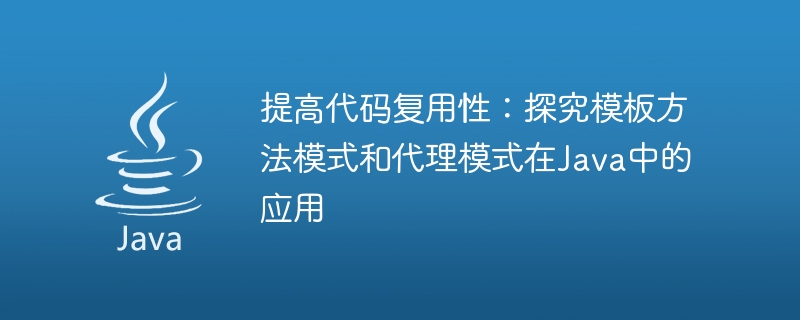

Improving code reusability: exploring the application of template method pattern and proxy pattern in Java
Introduction:
In software development, code reuse is a A very important technical means, it can greatly improve development efficiency, reduce code redundancy, and help maintain and manage code. In the Java language, the template method pattern and the proxy pattern are two commonly used design patterns, which can help us achieve code reuse. This article will introduce the concepts and application scenarios of these two design patterns in detail, and demonstrate their practical application in the Java language through specific code examples.
1. Template method pattern
abstract class Animal {
public void live() {
eat();
sleep();
play();
}
public abstract void eat();
public abstract void sleep();
public abstract void play();
}
class Cat extends Animal {
public void eat() {
System.out.println("猫吃鱼");
}
public void sleep() {
System.out.println("猫睡觉");
}
public void play() {
System.out.println("猫玩耍");
}
}
class Dog extends Animal {
public void eat() {
System.out.println("狗吃骨头");
}
public void sleep() {
System.out.println("狗睡觉");
}
public void play() {
System.out.println("狗玩球");
}
}
public class Main {
public static void main(String[] args) {
Animal cat = new Cat();
cat.live();
Animal dog = new Dog();
dog.live();
}
}In the above code, the Animal class is an abstract class, which defines a live() method, which is the skeleton of the entire algorithm, in which some common steps are defined and some The specific implementation of the steps is left to subclasses. The Cat class and the Dog class are subclasses of Animal respectively. They implement the eat(), sleep() and play() methods, and perform different implementations according to the specific subclasses, thereby achieving code reuse and expansion.
2. Proxy pattern
interface Image {
void display();
}
class RealImage implements Image {
private String fileName;
public RealImage(String fileName) {
this.fileName = fileName;
loadFromDisk();
}
private void loadFromDisk() {
System.out.println("从磁盘加载图片:" + fileName);
}
public void display() {
System.out.println("显示图片:" + fileName);
}
}
class ProxyImage implements Image {
private String fileName;
private RealImage realImage;
public ProxyImage(String fileName) {
this.fileName = fileName;
}
public void display() {
if (realImage == null) {
realImage = new RealImage(fileName);
}
realImage.display();
}
}
public class Main {
public static void main(String[] args) {
Image image = new ProxyImage("test.jpg");
image.display();
}
}In the above code, Image is an interface, RealImage is the implementation class of Image, and ProxyImage is a proxy class. In ProxyImage, by introducing the RealImage object, the actual image display operation is delegated to RealImage. In the client code, we only need to use the ProxyImage object to access the image without directly operating the RealImage object. Through the proxy object, we can perform some additional operations before accessing the actual image, such as detecting whether the image exists, recording logs, etc.
Conclusion:
By using the template method pattern and proxy pattern, we can improve the reusability of the code and increase the flexibility and scalability of the code. The template method pattern provides a stable algorithm framework that allows subclasses to rewrite and modify it according to actual conditions. The proxy pattern allows us to add additional functionality and control without changing the actual object by introducing proxy objects.
When we are faced with the need to reuse existing code, or add new functions without changing the original code, we might as well consider using the template method pattern and proxy pattern, which can help us implement the code. Reuse and extend, improve development efficiency, reduce code redundancy, and help maintain and manage code. I hope that through the introduction and code examples of this article, readers can have a clearer understanding of the template method pattern and the proxy pattern, so that they can be better applied to actual software development.
The above is the detailed content of Applying template method pattern and proxy pattern in Java: improving code reusability. For more information, please follow other related articles on the PHP Chinese website!




